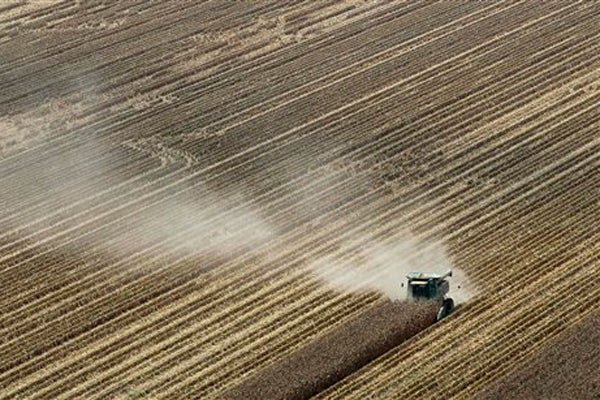|
September 5, 2013
Global warming has increased risk of record heat, say Stanford scientists
Researchers calculate that intense heat like that in the summer of 2012 is up to four times more likely to occur now than in pre-industrial America, when there was much less carbon dioxide in the atmosphere. By Rob Jordan

Dust rises from a Midwest cornfield during the drought of 2012. Extreme weather will become more common as the world's climate warms. (Photo: Danny Johnston / AP Photo)
Drought shriveled crops in the Midwest, massive wildfires raged in the West and East Coast cities sweltered. The summer of 2012 was a season of epic proportions, especially July, the hottest month in the history of U.S. weather record keeping.
And it's likely that we'll continue to see such calamitous weather.
In the north-central and northeastern United States, extreme weather is more than four times as likely to occur than it was in the pre-industrial era, according to a new study by Noah Diffenbaugh, a Stanford associate professor of environmental Earth system science, and Martin Scherer, a research assistant in the department.
Diffenbaugh and Scherer found strong evidence that the high levels of greenhouse gases now in the atmosphere have increased the likelihood of severe heat such as occurred in the United States in 2012.
The researchers focused primarily on understanding the physical processes that created the hazardous weather. They looked at how rare those conditions were over the history of available weather records, going back over the last century.
Then, using climate models, they quantified how the risk of such damaging weather has changed in the current climate of high greenhouse gas concentrations, as opposed to an era of significantly lower concentrations and no global warming. Their findings don't pinpoint global warming as the cause of particular extreme weather events, but they do reveal the increasing risk of such events as the world warms.
"Going forward, if we want to understand and manage climate risks, it's more practically relevant to understand the likelihood of the hazard than to ask whether any particular disaster was caused by global warming," said Diffenbaugh, a senior fellow at the Stanford Woods Institute for the Environment.
In 2012 alone, the United States suffered 11 extreme weather events that each caused at least $1 billion in damage. "It's clear that our greenhouse gas emissions have increased the likelihood of some kinds of extremes, and it's clear that we're not optimally adapted to that new climate," Diffenbaugh said.
While Diffenbaugh cautions against trying to determine whether global warming caused any individual extreme event, the observed global warming clearly appears to have affected the likelihood of record heat, according to Diffenbaugh and Scherer.
The study, looking at the likelihood of July 2012 U.S. temperatures recurring, is part of a larger report edited by scientists at the National Oceanic and Atmospheric Administration (NOAA) and published Sept. 5 in the Bulletin of the American Meteorological Society. The report includes studies of a dozen 2012 extreme weather events by research teams around the world, about half of which found some evidence that human-caused climate change contributed to an extreme weather event.
Close study of extreme weather events can help quantify the likelihood that society will face conditions similar to those that occurred in the summer of 2012, thereby informing efforts to reduce vulnerability and increase resilience. Diffenbaugh argues that the new results can also help to quantify the true cost of emissions to society, since the cost of the disaster is measurable.
"Knowing how much our emissions have changed the likelihood of this kind of severe heat event can help us to minimize the impacts of the next heat wave, and to determine the value of avoiding further changes in climate," Diffenbaugh said.
Funding for this research was provided by the National Science Foundation and the National Institutes of Health.
Rob Jordan is the communications writer for the Stanford Woods Institute for the Environment.
For more Stanford experts on climate change and other topics, visit Stanford Experts.
-30-
|